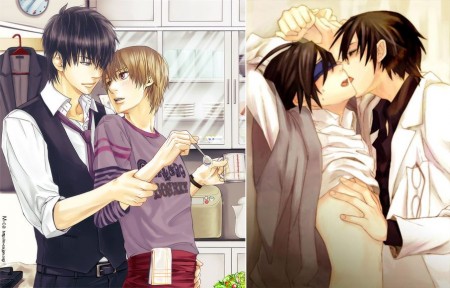Ask John: Does Gay Manga Have Categorized Degrees?
Question:
What exactly is the difference between Shoujo-ai and Yuri and Shonen-ai and Yaoi? I’ve always been told that Shonen-ai and Shoujo-ai deal with crushes and romances between characters of the same sex and that Yuri and Yaoi deal with pornography and erotica between characters of the same sex. But, some sources say that the terms are interchangeable, Shoujo-ai with Yuri and Shonen-ai with Yaoi, what the real truth here?
Answer:
According to experts including Kanagawa University professor James Welker, “shounen ai” originated in early 1970’s manga as a version of shoujo manga focused on male characters. Like shoujo manga, original shounen ai manga focused on character relationships and emotions and depicted young men developing strong, intimate friendships with each other. As these manga stories became more popular, they got parodied in amateur fan comics that took the platonic “bromance” stories to the next stage, depicting homosexual sex. These fan-fiction stories that just focused on the sex, jettisoning the emotional drama became known as “Yama nashi, ochi nashi, imi nashi” (“No peak, no fall, no meaning) or “yaoi.” These stories had no dramatic build-up or story resolution; they were just supplemental fan-fiction pornography designed to show what the original dramatic manga stories didn’t. The concept of “shoujo ai” and “yuri,” however, has a less distinct separation because traditionally shoujo ai and yuri have referred to the same thing. Mid-1970s manga artists such as Ryoko Ikeda published manga stories about deeply affectionate and respectful relationships between young women. These stories about platonic “shoujo ai” came to be referred to as “Yuri” after the given name common to many characters in these stories. Traditionally shoujo ai stories were platonic manga created by female artists. While some underground amateur-produced manga of the 1980s dealt with pornographic lesbianism, many of the girl-girl lesbian stories that emerged in the 1980s came from male creators and anime. Typically, since the mid-1970s when the “Yuri” trope emerged, genuine “shoujo ai” and “yuri” stories by female creators for female readers have been shoujo-esque with a heavy focus on emotional and narrative development. The vast majority of pornographic lesbian depictions in Japanese manga and anime have actually come from male creators targeting male readers and viewers, so although these stories may be called “yuri” or “shounen ai,” they actually have relatively little in common with true shoujo-esque yuri manga.
In simple summation, traditionally “Shounen ai” refers to platonic or “softcore” romance stories between men while “yaoi” refers to homosexual pornography. The terms “shoujo ai” and “yuri” are interchangeable. Contemporary pornographic lesbian stories including the Cream Lemon “Escalation” and “Pop-Chaser” stories, Torajiro Kishi’s Maka-Maka, Shinichiro Sano’s Sono Hanabira ni Kuchizuke wo, and Ken Kurogane’s Shoujo Sect have all been hentai stories created by male creators and published or marketed for male consumers rather than created and distributed in the traditional “yuri” channels.


